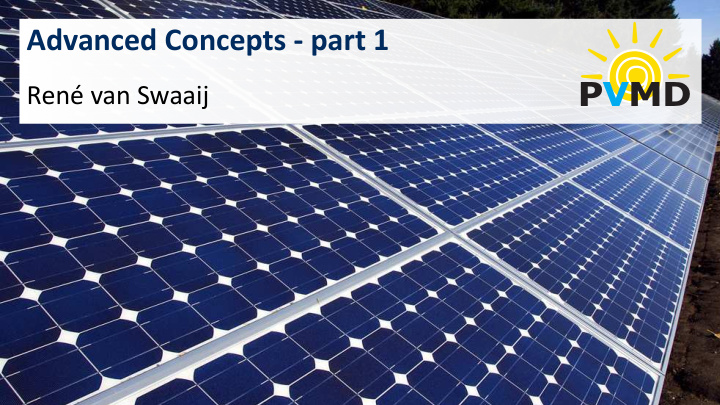



Advanced Concepts - part 1 René van Swaaij PVMD Delft University of Technology
Learning objectives • Design of the ideal solar cell
Learning objectives • Design of the ideal solar cell • Advanced concepts based on crystalline silicon:
Learning objectives • Design of the ideal solar cell • Advanced concepts based on crystalline silicon: • Passivated emitter
Learning objectives • Design of the ideal solar cell • Advanced concepts based on crystalline silicon: • Passivated emitter • TOPCon
Learning objectives • Design of the ideal solar cell • Advanced concepts based on crystalline silicon: • Passivated emitter • TOPCon • Metal wrap-through
Shockley-Queisser limit Efficiency limit for single • junction solar cells Si
Shockley-Queisser limit Efficiency limit for single • junction solar cells Si Silicon: 29.4% • Richter et al., IEEE-JPV 4 , 1184-1191 (2013)
Shockley-Queisser limit Efficiency limit for single • junction solar cells Si Silicon: 29.4% • Auger recombination • Richter et al., IEEE-JPV 4 , 1184-1191 (2013)
Shockley-Queisser limit Efficiency limit for single • junction solar cells Si Silicon: 29.4% • Auger recombination • Intrinsic c-Si of 110 µm • Richter et al., IEEE-JPV 4 , 1184-1191 (2013)
Passivated Emitter, Rear Locally-diffused (PERL) Efficiency up to 25.0% Zhao et al. APL 73 , 1991-1993 (1998)
Passivated Emitter, Rear Locally-diffused (PERL) 1. Inverted pyramids with ARC for light trapping Efficiency up to 25.0% Zhao et al. APL 73 , 1991-1993 (1998)
Passivated Emitter, Rear Locally-diffused (PERL) 1. Inverted pyramids with ARC for light trapping 2. Oxide layer for surface passivation Efficiency up to 25.0% Zhao et al. APL 73 , 1991-1993 (1998)
Passivated Emitter, Rear Locally-diffused (PERL) 1. Inverted pyramids with ARC for light trapping 2. Oxide layer for surface passivation 3. High quality FZ wafer Efficiency up to 25.0% Zhao et al. APL 73 , 1991-1993 (1998)
Passivated Emitter, Rear Locally-diffused (PERL) 1. Inverted pyramids with ARC for light trapping 2. Oxide layer for surface passivation 3. High quality FZ wafer 4. Reduced area for metal contact Efficiency up to 25.0% Zhao et al. APL 73 , 1991-1993 (1998)
Passivated Emitter, Rear Locally-diffused (PERL) 1. Inverted pyramids with ARC for light trapping 2. Oxide layer for surface passivation 3. High quality FZ wafer 4. Reduced area for metal contact 5. Highly doped p + and n + Efficiency up to 25.0% regions near contacts Zhao et al. APL 73 , 1991-1993 (1998)
Passivated Emitter Rear Contact (PERC) Standard cell PERC cell Efficiency up to 21.3% for multi -crystalline Si solar cell (Trina Solar, China) Source figure: ISFH Zhang et al., IEEE-JPV 6 , 145-152 (2016)
Tunnel Oxide Passivated Contact metal fingers passivating thin film p + - emitter antireflection coating n -base Phosphorus n+ Si layer ultra-thin tunnel oxide (SiO 2 ) metallization Source figure: Feldmann et al., SolMat 120 , 270-274 (2014)
Tunnel Oxide Passivated Contact metal fingers passivating thin film p + - emitter antireflection coating n -base Phosphorus n+ Si layer ultra-thin tunnel oxide (SiO 2 ) metallization Source figure: Feldmann et al., SolMat 120 , 270-274 (2014)
Ultra-thin Tunnel Oxide Efficiency up to 25.1% Source figure: Tao et al., AIMS Material Science 3(1) , 180-189 (2016)
Standard cell integration Solar cell ‘tabbing’ • busbar n-type emitter p-type base back contact
Standard cell integration Solar cell ‘tabbing’ • Surface area lost by cell • spacing busbar n-type emitter p-type base back contact
Metal wrap-through (MWT) Front contact ‘wrapped- • through’ solar cell base n-type emitter p-type base ‘front’ contact back contact
Metal wrap-through (MWT) Front contact ‘wrapped- • through’ solar cell base All contacts on the back • n-type emitter p-type base ‘front’ contact back contact
Metal wrap-through (MWT) Front contact ‘wrapped- • through’ solar cell base All contacts on the back • Cell spacing reduced • Sunweb technology by SCHOTT Solar and Solland Solar (2011) n-type emitter p-type base ‘front’ contact back contact
Summary • PERC most commonly produced crystalline silicon solar cell
Summary • PERC most commonly produced crystalline silicon solar cell • TOPCon replaces back surface field with a tunneling layer
Summary • PERC most commonly produced crystalline silicon solar cell • TOPCon replaces back surface field with a tunneling layer • Metal wrap-through enables a more optimized module design
Recommend
More recommend